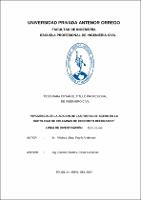Influencia de la adición de las fibras de acero en la ductilidad de columnas de concreto reforzado

View/
Download
(application/pdf: 5.816Mb)
(application/pdf: 5.816Mb)
Date
2017Author(s)
Vílchez Ulloa, Frank Anderson
Metadata
Show full item recordAbstract
Las columnas de concreto reforzado deben incursionar en el rango
inelástico para disipar gran parte de la energía, con el fin qué, se mantenga
la resistencia y capacidad de disipar energía se requiere que el elemento
sea dúctil, por tal motivo en la norma E060 del año 2009 del RNE
(Reglamento Nacional de Edificaciones), se establecen requisitos, como
por ejemplo, refuerzo transversal, separaciones máximas, longitud de
confinamiento (Lo) y ganchos sísmicos.
Cuando una columna se comprime axialmente, el material es empujado
hacia fuera, dando como resultado dimensiones aumentadas de la sección
transversal conllevando a la disminución de su resistencia a carga axial.
Es por ello que surge la necesidad de incluir las fibras de acero en la matriz
de concreto para que actúen activándose una serie de mecanismos que se
oponen al avance del desprendimiento del concreto, denominándose a este
efecto aumento de la tenacidad dando como resultado incremento de la
ductilidad.
Se realizó el programa experimental incluyendo el diseño, construcción y
prueba de las 18 columnas bajo carga concentrada concéntrica. Fueron 6
muestras las cuales fueron construidas con concreto convencional con
áreas de acero longitudinal de 3/8”,12 mm y 1/2““, además se construyó 12
muestras con misma área de acero ya mencionadas pero incluyéndolas a
las muestras los respectivos porcentaje de fibra de acero 38.25kg/m3 y
58.87kg/m3
Con la inclusión de 58.87 kg/m3 de fibras de acero se obtiene mejores
resultados en cuanto la Ductilidad y capacidad de Resistencia a Carga
Axial. Reinforced concrete columns must venture the inelastic range to dissipate
much of the energy, so that, if resistance and energy dissipation are
maintained, the element is required to be ductile. In the E060 standards of
the RNE 2009, transverse reinforcement requirements are established,
such as maximum separations, confinement length (Lo) and seismic hooks.
When a column was compressed axially, the material is pushed outward,
resulting in increased cross-sectional dimensions and in turn lowering its
axial load resistance.
It is for this reason that the need arises to include the steel fibers in the
concrete matrix so that they act by activating a series of mechanisms that
oppose to the advance of the detachment of the concrete, denominating to
this effect increase of the tenacity resulting in increase of the ductility.
The experimental program was carried out including the design,
construction and testing of the 18 columns under concentrated concentric
load. There were 6 samples which were constructed with conventional
concrete with areas of 3/8 ““, 12 mm and 1/2““ longitudinal steel, in addition
12 samples with the same area of steel already mentioned but including the
respective percentage of Steel fiber 38.25kg/m3 and 58.87kg/m3
With the inclusion of 58.87 kg / m3 of steel fibers, better results was obtained
in terms of Ductility and capacity of Resistance to Axial Load.
Subject
Collections
- Ingeniería Civil [1260]

